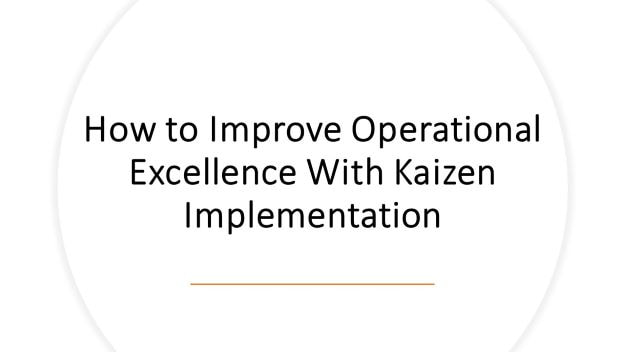- Aligning goals with business strategy.
- Creating an operational excellence team.
- Establishing the culture.
These steps will help you create a successful Kaizen implementation. If you want to make your organization an operational excellence champion, follow these steps. You'll soon be on your way to building a culture of continuous improvement!
Aligning goals with business strategy-
Aligning goals with your business strategy is the first step in implementing a Kaizen program. This process emphasizes the need for constant improvement. Kaizen methods have helped many organizations increase employee productivity and lower costs, while improving customer service and satisfaction. The ultimate goal of any organization is operational excellence, and Kaizen implementation is one way to achieve it. While projects and tools can help, a true culture change can be achieved with Kaizen. All employees are encouraged to participate in the improvement process.
The next step is to align goals with the overall business strategy. Developing an operational excellence mindset requires the company to align its goals with its business strategy. By doing this, all members can see the value flow through the business. Moreover, successful implementation of Kaizen practices requires businesses to focus on improving their value proposition and delivery.
By applying Kaizen methods, companies can improve their business performance by 25% or more. They will also be able to achieve long-term sustainable growth and create a work culture that is ideal for the employees. |
Creating an operational excellence team-
Creating an operational excellence team will require a commitment to a vision that is aligned with the company's strategic objectives. The vision can be product or growth-oriented, or even market-focused. It should be communicated to all employees, to ensure alignment of effort and resources. Once all employees are on board with the new strategy, implementation will be easier. However, a company wide OpEx strategy will require time, resources, and education to be successful.
Before implementing any improvement initiative, a company should define an optimal value stream and work toward achieving it. Once a company has defined the optimal value stream, it should select a project that is both timely and effective. The company should then expand its operational excellence team by hiring more staff and establishing a portfolio of improvement projects. This team should be rewarded for its accomplishments and recognize the individual contributions of its frontline operational excellence leaders.
In order to implement a Kaizen implementation successfully, an organization must first determine what operational excellence is. To determine if a process meets those criteria, management must identify the problem and determine how to resolve it. An effective operational excellence team must be committed to bringing changes and identifying recurring problems. However, the team must be willing to embrace change and sacrifice old ways of doing things. It is vital to measure progress and make sure everyone understands what it means to achieve the goals.
When implementing a Kaizen program, companies must realize that they cannot achieve operational excellence without aligning their goals with the organization's strategic objectives. Without this alignment, improvement efforts tend to float in circles, with little or no strategic impact. Ultimately, it is imperative to align goals with strategic objectives. Only then can Kaizen efforts benefit the entire organization and its customers.
Coming to the third critical component of continuous improvement culture- establishing the culture of continuous improvement at your workplace.
Creating a culture of continuous improvement-
Creating a culture of continuous improvement is important, but how do you make it stick? The key is to get everyone involved. Rather than enlisting the help of managers and top executives, employees should make suggestions for improvement. While not every suggestion will be successful, many will. Employees are most familiar with areas that need improving, so gaining their input can be invaluable. Below are some tips for making Kaizen work at your organization:
Commitment:
Kaizen requires the commitment of every member of the organization. There must be no "us versus us" mentality. All must work toward the same goal. For example, some automobile factories hold daily meetings of small teams to discuss one small change that can improve a process. This process must be conducted regularly, daily, and in a routine. Once implemented, the company will be on the road to continuous improvement.
Motivation:
Employees should be encouraged to take responsibility for the quality of their work. Kaizen will improve processes while instilling a sense of teamwork and ownership. Employees will be motivated to work on the problems they select and will be more likely to find a solution if everyone is involved in it. Recently published studies (referred below) revealed that only 32% of US workers were engaged in their work, while 17% were ‘actively disengaged’. Moreover, a steady decline in employee engagement is observed when you study reports from year 2020 till date. Globally, only 23% of employees are engaged at work.
These figures are truly alarming and it's about time business leaders change the way work gets managed. In my view employee engagement is not just a HR (human resources) function. HR surely has a big role to play, but taking care of your people is a primary role of a team leader, doesn't matter at what step he/she is on the corporate ladder.
Getting employees involved and motivated is key for bringing about operational excellence. And Kaizen is one of the surest, easiest and cost-effective route for increasing employee engagement and in turn operational excellence.
Read more on Kaizen here.
References-
Related reading:
#operationalexcellence #kaizen #kaizenimplementation #strategicdecisions #strategy #strategicdecisionmaking #strategymanagement #decisiontools #decisionmaking #strategicplanning #challengesofdecisionmaking





















